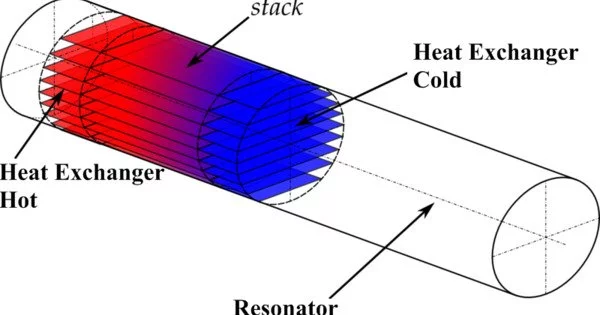Thermoacoustic engines are devices that convert heat into acoustic power or vice versa. They work on the principle of thermoacoustics, which is the study of the interaction between temperature, pressure, and acoustic waves in a medium. The basic components of a thermoacoustic engine include a heat source, a resonator, and a stack of plates or tubes.
In a thermoacoustic engine, a heat source is used to create a temperature gradient in the stack of plates or tubes. The hot end of the stack is typically placed close to the heat source, while the cold end is farther away. As the heat flows from the hot end to the cold end, it creates pressure oscillations in the stack of plates or tubes. These pressure oscillations generate acoustic waves that can be converted into useful work.
It also known as “TA engines” are thermoacoustic devices that use high-amplitude sound waves to pump heat from one location to another (this requires work, which the loudspeaker provides) or use a heat difference to produce work in the form of sound waves (these waves can then be converted into electrical current in the same way that a microphone does).
These devices can be built to use either a standing or a moving wave. Thermoacoustic refrigerators, unlike vapor refrigerators, have no coolant and few moving parts (only the loudspeaker), and thus do not require dynamic sealing or lubrication.
Operation
Thermoacoustic engines have several advantages over traditional engines. They have no moving parts, which means they are less prone to wear and tear and require less maintenance. They are also very quiet, which makes them ideal for use in noise-sensitive environments. Additionally, they can operate on a variety of fuels, including natural gas, propane, and hydrogen.
A thermoacoustic device takes advantage of the fact that parcels of gas alternately compress and expand in a sound wave, and pressure and temperature change simultaneously; when the pressure reaches a maximum or minimum, so does the temperature. Heat exchangers, a resonator, and a stack (on standing wave devices) or a regenerator (on traveling wave devices) are the main components. Depending on the engine, a driver or loudspeaker may be used to produce sound waves.
Interference between two waves traveling in opposite directions at certain frequencies can occur in a tube that is closed at both ends. The interference produces resonance and a standing wave. The stack is made up of small parallel channels. When the stack is placed in a resonator with a standing wave, a temperature differential develops across the stack. Heat can be moved by placing heat exchangers on each side of the stack. The opposite is also possible: a temperature difference across the stack generates a sound wave. A heat pump is one example, and a prime mover is another.
Application
Thermoacoustic engines have a wide range of potential applications, including power generation, refrigeration, and air conditioning. They are particularly well-suited for remote and off-grid applications, where traditional engines may not be practical. With ongoing research and development, thermoacoustic engines have the potential to become an important part of the renewable energy landscape.
















